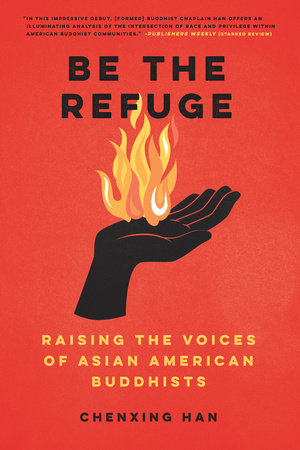Be the Refuge: Raising the voices of Asian American Buddhists
Chenxing Han
Jan 26, 2021
ISBN 9781623175238
The way Buddhism spread in America has largely ignored those who grew up practicing it. In the most pointed section of Chenxing Han’s Be the Refuge: Raising the Voices of Asian American Buddhists, she posits a question to a group: “Who do you think are the most famous Buddhist individuals in America?” Whenever this question arises, Han observes that most people think of people like the Dalai Lama or Thich Nhat Hanh, people who have dedicated their lives to Buddhism and have become celebrities for their beliefs. When the question gets more specific to Buddhists living in America, people like Robert Thurman, Steve Jobs and Richard Gere are brought to mind. When the final follow up question is asked: “What about Asian American Buddhists,” most people have their mind go blank. Be the Refuge explores the issue of erasure of Asian American Buddhists. It is a celebration of Asian American Buddhist practice that seeks to boost their exposure and call for a collective Asian American Buddhist identity.
Chenxing Han wrote Be the Refuge as an expansion of her thesis at the Institute of Buddhist Studies. In four sections, she weaves together stories from interviews conducted with her own story to create a picture of Asian American Buddhists. In the first section, Han explores fourth generation Japanese American Jodo Shinshu Buddhists, who are looking for community in their exploration of religion and identity. The second section tells the story of second generation Asian Americans whose immigrant parents culturally passed Buddhism down from generation to generation. Part three is about Asian Americans who grew up in other religions and converted to Buddhism, a group that has largely been forgotten about, even in the Buddhist community. Han’s work really begins to shine in the fourth section, where she begins to explore issues around identity, specifically the possibility of a pan-ethnic, pan-sectarian Asian American Buddhist identity. For the most part, each sect of Buddhism is very independent of one another, leading to many young Asian American Buddhists exploring issues around their religious identity in individual isolation. Collectively, however, there are many common themes; most important to Han is anger, a very unbuddhist emotion. This anger is rooted in the idea that there are “two Buddhisms,” one rational, meditation based and White and the other steeped in tradition and rituals and Asian.
Be the Refuge’s greatest strength is perhaps its biggest weakness as well. Han reached out to so many different communities and conducted over 80 interviews in order to complete this work. While she is able to paint a picture regarding their identity, she is forced to be succinct when doing so. In reality, exploring the identity of any of these groups could be enough for its own work. As this is one of the first works to explore many different sects of Asian American Buddhist, I’m left wanting more description of these groups and the individual exploration of identity within them, which could bolster the argument for a collective identity. Han’s exploration of a collective Asian American Buddhist identity is relatively new in non-fiction American literature about Buddhism, and I’m interested to see if others will build upon Han’s research.
Review by Tim Chu. Editing assistance by Anastasia Chiu.

